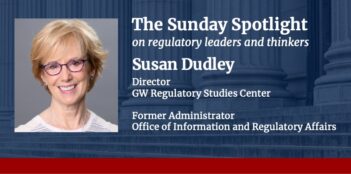
Understanding the process reveals why the fiscal cliff should be avoided.
Now that the election is over, the two political parties will face a vital policy decision during the post-election session of Congress: whether to defer the scheduled trigger date for the sequestration of $109 billion in federal spending in 2013 and the expiration of the Bush tax cuts beyond January 2, 2013, or whether to have this cut in spending and tax increases occur, have the country plunge off the so-called fiscal cliff, and run the risk of a double dip recession.
Most discussions of sequestration consider its political implications—how triggering the sequester might affect the relative ability of the two parties to impose their preferences on the mix of spending cuts and tax increases to be included in a mega-fiscal deal intended to address the country’s structural fiscal deficit. So far, by contrast, few observers have discussed how federal agencies would actually implement the sequestration, what difficult choices senior agency officials would face in trying to protect the national interest while making these cuts, and how the agency actions would ultimately influence the dynamics of the fiscal policy dispute.
My work experience in the Office of Management and Budget (OMB), where I led the legal team that implemented the Gramm-Rudman-Hollings sequestration in 1986, may provide valuable insights into how this process works—and why it must be avoided.
Unless the two parties agree in the lame duck session to defer sequestration, on January 2, 2013, the President must order the permanent cancellation of $109 billion in federal spending in fiscal year 2013. This process, adopted in the Budget Control Act of 2011 to resolve the then-impending debt ceiling crisis, would impose indiscriminate, across-the-board cuts by applying a uniform percentage reduction on all covered programs—good and bad alike—without differentiation. The cuts would be divided equally between defense and civilian programs. Major entitlement programs like Social Security and Medicaid are exempt, and cuts to Medicare would be limited to 2%.
Sequestration is a doomsday device, never intended to be used, designed to force the two parties to agree on a fiscal solution by threatening major harm to the shared national interest. OMB, which has criticized sequestration as “a blunt and indiscriminate instrument” that “is not the responsible way for our Nation to achieve deficit reduction,” estimates that if the sequester occurs eligible defense programs will be cut by 9.2% in 2013 and non-defense programs by 8.4%. Since the cuts will be imposed starting in the second quarter of the fiscal year, the annualized rate of reductions would actually be 12.25% for defense programs and 11.2% for civilian programs. The uniform percentage cuts must be applied to each covered program, project or activity (PPA) in the federal budget. The President has no discretion in implementing the reductions. He must follow Congressional directives and may not, for example, shift required reductions from Treasury to Agriculture.
The sequestration will be implemented by OMB and the agencies. OMB will determine the uniform percentage cuts to be applied separately to each PPA in the federal budget. It also will issue to the agencies “apportionments,” which are formal orders, enforceable by criminal sanctions, that limit the amount of resources an agency may obligate in a fiscal quarter. Apportionments normally spread spending evenly through the four quarters, but the President could front load or back load the reductions by quarter if he wished.
The agencies will face the enormous burden of determining how to apply the uniform percentage reduction to each PPA. The Department of Defense alone has more than 2,500 PPAs, and collectively the other agencies have thousands more. Making thousands of individualized decisions about how to cut spending uniformly in specific programs will be a Herculean task.
Within an individual PPA, the agencies will have great discretion in determining how to allocate the reductions utilizing the three tools available: cutting public services, furloughing staff, and cutting government contracts. The pattern of reductions will vary greatly from agency to agency. For example, since around 80% of the budget of the General Accountability Office is for personnel, sequestration would require massive furloughs.
Agencies that rely extensively on contractors to deliver services will face the most complicated implementation decisions. Senior agency officials will have to run multiple scenarios to determine how to squeeze savings from the procurement portfolio while continuing to provide vital public services. The agencies would be forced to award fewer new contracts, not exercise options, scale back orders, and even terminate agreements. Small and medium-sized companies with government contracts would be at greater risk than larger entities. Service contractors would be affected more than manufacturers; employees can be eliminated easily, but of course planes cannot be built with one wing. Faced with three rounds of reductions in short order and without prior knowledge whether their contracts are targeted, companies would very likely not be able to determine how to plan their operations for the short- or long-term, causing them to reduce their spending, and thereby undermine efforts to restart a fragile economy.
If sequestration is triggered, the new Congress in January would conduct negotiations over fiscal policy with a gun held to its head, and with the sequestration clock ticking. Significant harm to the national interest would occur automatically unless the parties could reach agreement by March 31, the end of the second fiscal quarter.
Sequestration is a back-loaded process. Nothing would happen on Day 1 after the sequester is ordered. The agencies are not required to take any immediate or irreversible actions. Their legal obligations would be to impose steep cuts by March 31st, and make equal reductions by June 30th and September 30th. In the weeks immediately after sequestration is ordered, the agencies could accommodate the inevitable political pressure to defer cuts while negotiations continue. But, every day they waited to make cuts in anticipation of a Congressional accord, the size of the reductions the agencies would have to impose suddenly at quarter’s end would increase. If the parties cannot agree on extending the trigger date, then at some unpredictable date in late February or early March, the agencies would be forced to start making drastic cuts with no advance warning.
The Treasury Department estimates that the country will hit the current debt ceiling in early March, just as the major sequestration cuts would have to be imposed. The confluence of these two events creates the potential for a major self-inflicted wound if the policy process were to deadlock again in March. To avoid
this nightmare scenario, Congress would be well advised to adopt a short-term deferral of the trigger date for sequestration and the tax increases, moving it into the time period for the budget reconciliation process in mid-2013.




